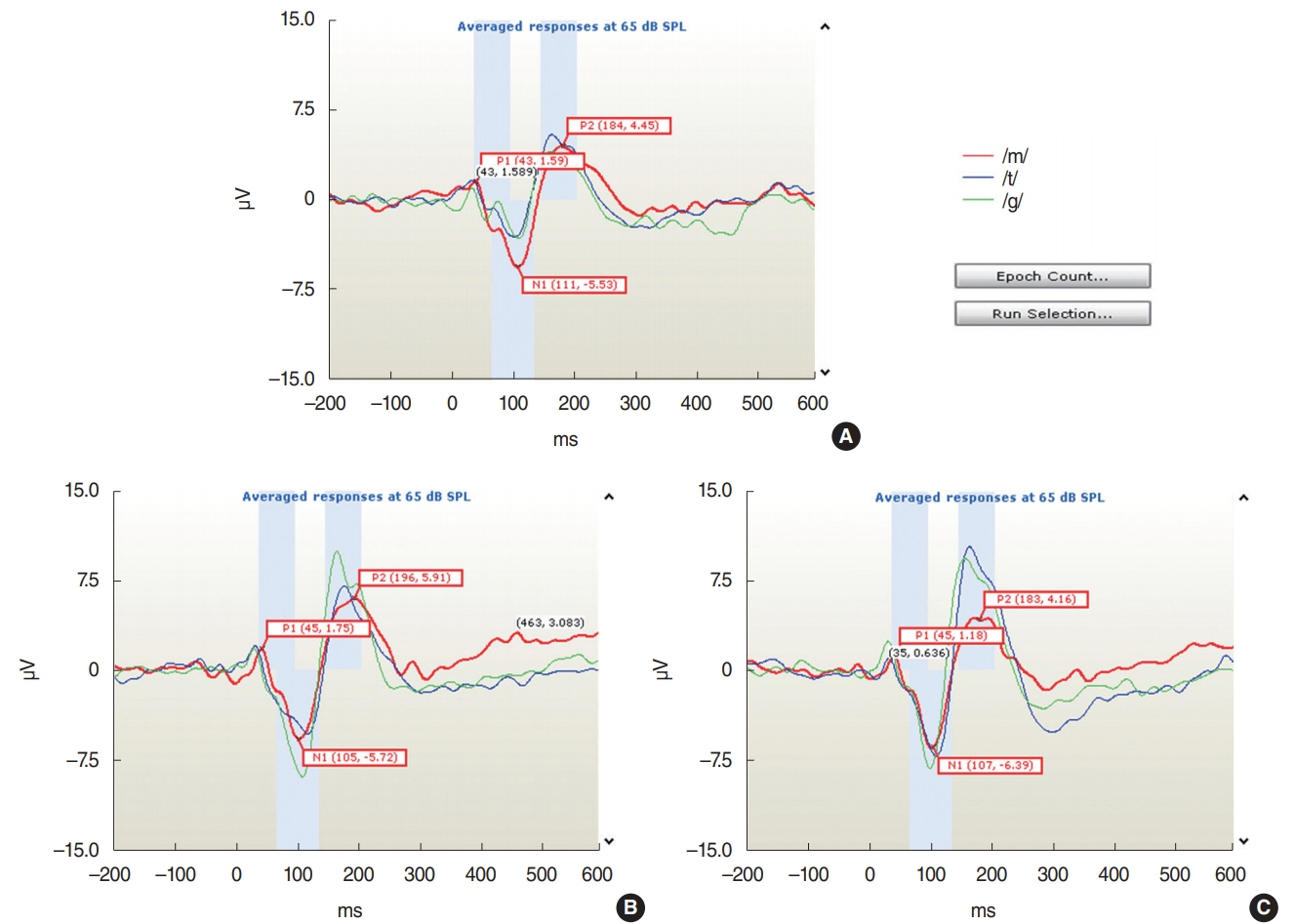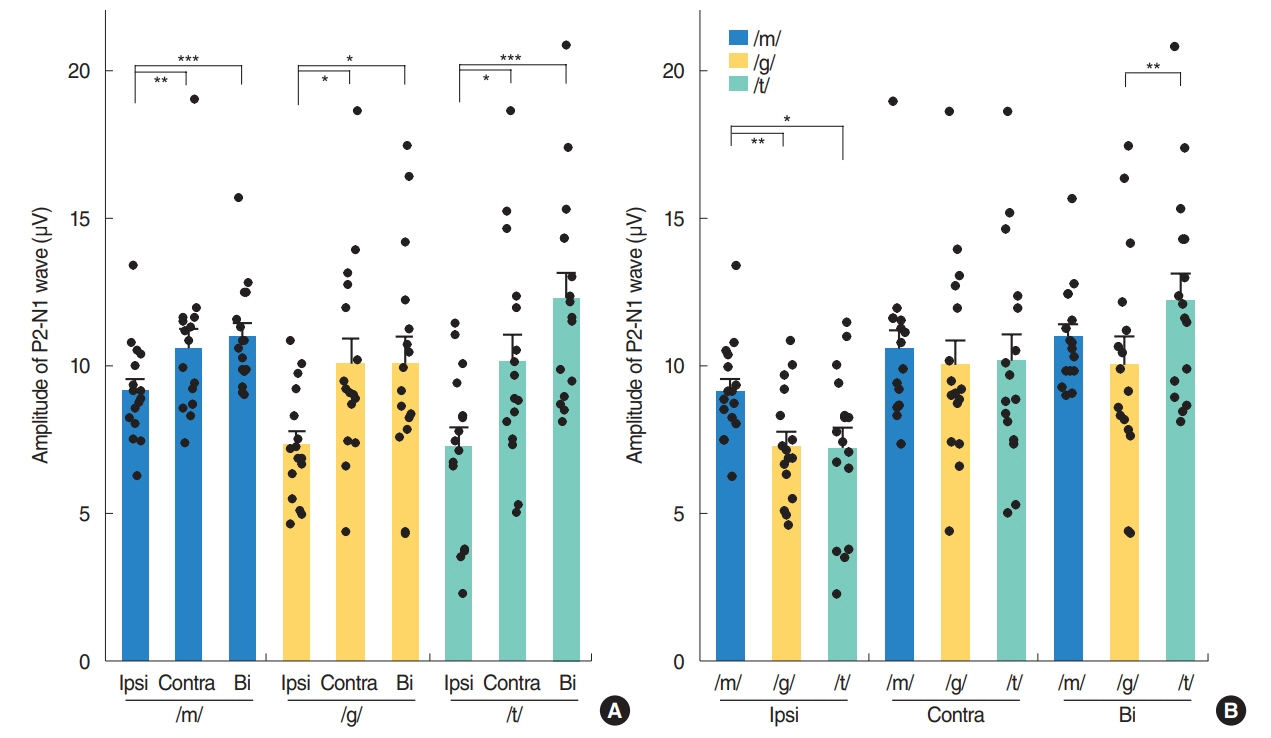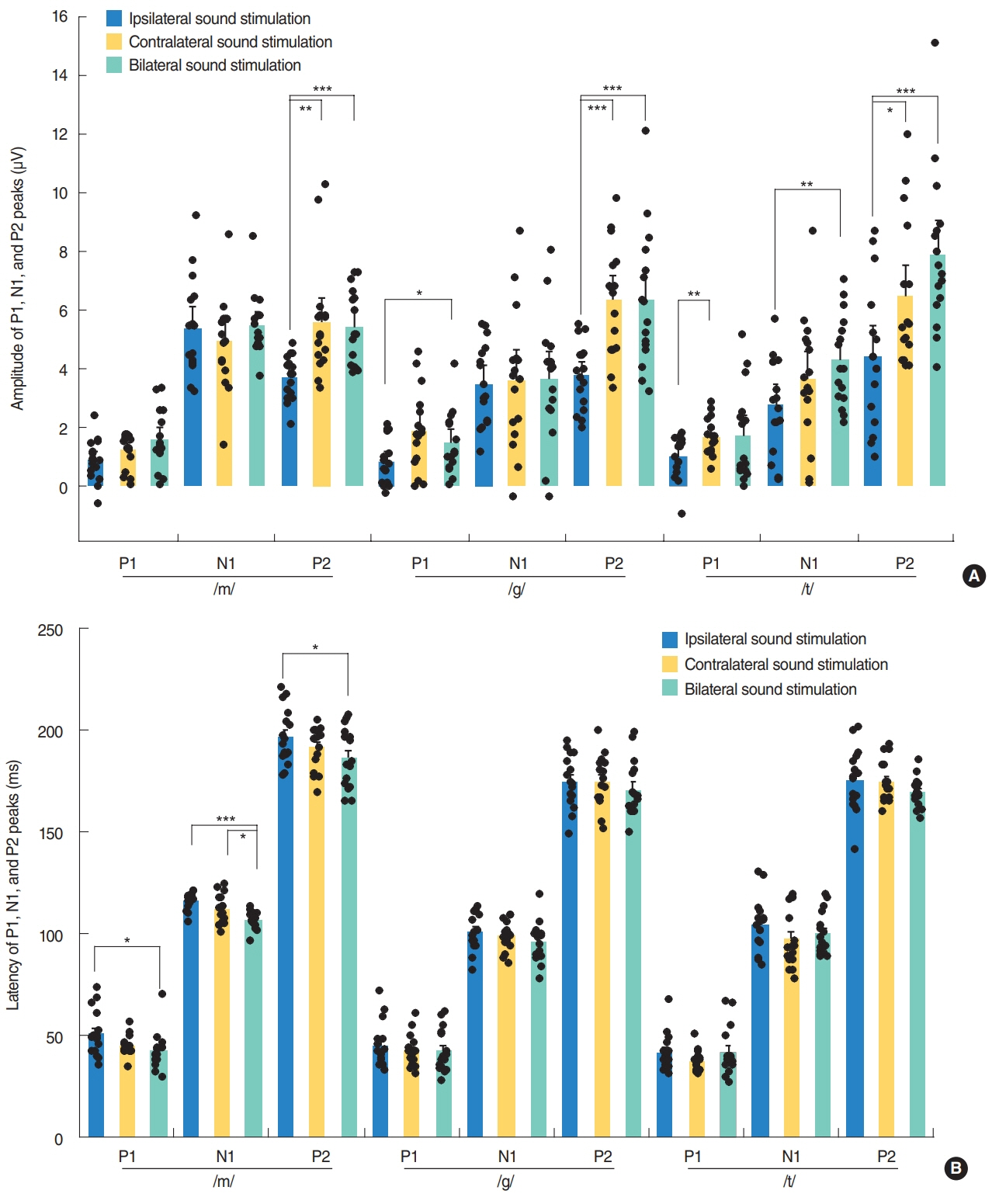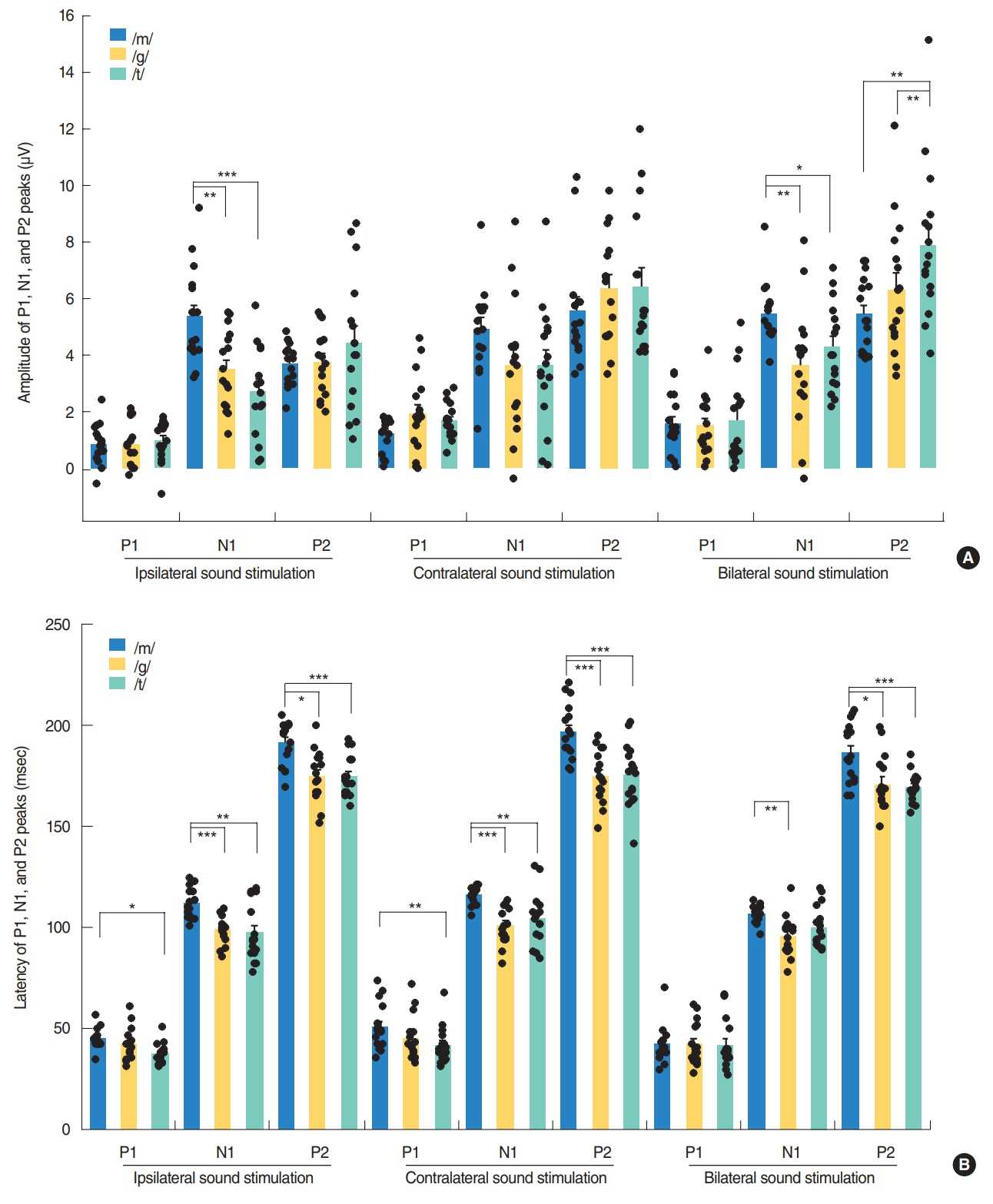Clin Exp Otorhinolaryngol.
2020 May;13(2):133-140. 10.21053/ceo.2019.00801.
Changes in Cortical Auditory Evoked Potentials by Ipsilateral, Contralateral and Binaural Speech Stimulation in Normal-Hearing Adults
- Affiliations
-
- 1Department of Otorhinolaryngology-Head and Neck Surgery, Asan Medical Center, University of Ulsan College of Medicine, Seoul, Korea
- 2Department of Otorhinolaryngology-Head and Neck Surgery, Ulsan University Hospital, University of Ulsan College of Medicine, Ulsan, Korea
- KMID: 2500285
- DOI: http://doi.org/10.21053/ceo.2019.00801
Abstract
Objectives
. Cortical auditory evoked potentials (CAEPs) have been used to examine auditory cortical development or changes in patients with hearing loss. However, there have been no studies analyzing CAEP responses to the different sound stimulation by different stimulation sides. We characterized changes in normal CAEP responses by stimulation sides in normal-hearing adults.
Methods
. CAEPs from the right auditory cortex were recorded in 16 adults following unilateral (ipsilateral and contralateral) and bilateral sound stimulation using three speech sounds (/m/, /g/, and /t/). Amplitudes and latencies of the CAEP peaks in three conditions were compared.
Results
. Contralateral stimulation elicited larger P2-N1 amplitudes (sum of P2 and N1 amplitudes) than ipsilateral stimulation regardless of the stimulation sounds, mostly due to the larger P2 amplitudes obtained, but elicited comparable P2-N1 amplitudes to bilateral stimulation. Although the P2-N1 amplitudes obtained with the three speech sounds were comparable following contralateral stimulation, the /m/ sound elicited the largest P2-N1 amplitude in ipsilateral stimulation condition due to the largest N1 amplitude obtained, whereas /t/ elicited larger a P2-N1 amplitude than /g/ in bilateral stimulation condition due to a larger P2 amplitude.
Conclusion
. Spectrally different speech sounds and input sides are encoded differently at the cortical level in normal-hearing adults. Standardized speech stimuli, as well as specific input sides of speech, are needed to examine normal development or rehabilitation-related changes of the auditory cortex in the future.
Figure
Reference
-
1. Ostroff JM, Martin BA, Boothroyd A. Cortical evoked response to acoustic change within a syllable. Ear Hear. 1998; Aug. 19(4):290–7.
Article2. Purdy SC, Kelly AS, Thorne PR. Auditory evoked potentials as measures of plasticity in humans. Audiol Neurootol. 2001; Jul-Aug. 6(4):211–5.
Article3. Sharma A, Dorman MF. Central auditory development in children with cochlear implants: clinical implications. Adv Otorhinolaryngol. 2006; 64:66–88.4. Ponton CW, Eggermont JJ, Kwong B, Don M. Maturation of human central auditory system activity: evidence from multi-channel evoked potentials. Clin Neurophysiol. 2000; Feb. 111(2):220–36.
Article5. Munro KJ, Purdy SC, Ahmed S, Begum R, Dillon H. Obligatory cortical auditory evoked potential waveform detection and differentiation using a commercially available clinical system: HEARLab™. Ear Hear. 2011; Nov-Dec. 32(6):782–6.
Article6. Sharma A, Dorman MF, Spahr AJ. A sensitive period for the development of the central auditory system in children with cochlear implants: implications for age of implantation. Ear Hear. 2002; Dec. 23(6):532–9.
Article7. Billings CJ, Tremblay KL, Souza PE, Binns MA. Effects of hearing aid amplification and stimulus intensity on cortical auditory evoked potentials. Audiol Neurootol. 2007; 12(4):234–46.
Article8. Mehta K, Watkin P, Baldwin M, Marriage J, Mahon M, Vickers D. Role of cortical auditory evoked potentials in reducing the age at hearing aid fitting in children with hearing loss identified by newborn hearing screening. Trends Hear. 2017; Jan-Dec. 21:2331216517744094.
Article9. Punch S, Van Dun B, King A, Carter L, Pearce W. Clinical experience of using cortical auditory evoked potentials in the treatment of infant hearing loss in Australia. Semin Hear. 2016; Feb. 37(1):36–52.
Article10. Ponton CW, Don M, Eggermont JJ, Waring MD, Kwong B, Masuda A. Auditory system plasticity in children after long periods of complete deafness. Neuroreport. 1996; Dec. 8(1):61–5.
Article11. Tomlin D, Rance G. Maturation of the central auditory nervous system in children with auditory processing disorder. Semin Hear. 2016; Feb. 37(1):74–83.
Article12. Picton T. Hearing in time: evoked potential studies of temporal processing. Ear Hear. 2013; Jul-Aug. 34(4):385–401.13. Wunderlich JL, Cone-Wesson BK, Shepherd R. Maturation of the cortical auditory evoked potential in infants and young children. Hear Res. 2006; Feb. 212(1-2):185–202.
Article14. Carter L, Dillon H, Seymour J, Seeto M, Van Dun B. Cortical auditory-evoked potentials (CAEPs) in adults in response to filtered speech stimuli. J Am Acad Audiol. 2013; Oct. 24(9):807–22.
Article15. Agung K, Purdy SC, McMahon CM, Newall P. The use of cortical auditory evoked potentials to evaluate neural encoding of speech sounds in adults. J Am Acad Audiol. 2006; Sep. 17(8):559–72.
Article16. Purdy SC, Sharma M, Munro KJ, Morgan CL. Stimulus level effects on speech-evoked obligatory cortical auditory evoked potentials in infants with normal hearing. Clin Neurophysiol. 2013; Mar. 124(3):474–80.
Article17. Lister JJ, Harrison Bush AL, Andel R, Matthews C, Morgan D, Edwards JD. Cortical auditory evoked responses of older adults with and without probable mild cognitive impairment. Clin Neurophysiol. 2016; Feb. 127(2):1279–87.
Article18. Van Dun B, Kania A, Dillon H. Cortical auditory evoked potentials in (un)aided normal-hearing and hearing-impaired adults. Semin Hear. 2016; Feb. 37(1):9–24.
Article19. Small SA, Sharma M, Bradford M, Mandikal Vasuki PR. The effect of signal to noise ratio on cortical auditory-evoked potentials elicited to speech stimuli in infants and adults with normal hearing. Ear Hear. 2018; Mar-Apr. 39(2):305–17.
Article20. Golding M, Dillon H, Seymour J, Carter L. The detection of adult cortical auditory evoked potentials (CAEPs) using an automated statistic and visual detection. Int J Audiol. 2009; Dec. 48(12):833–42.
Article21. Pantev C, Ross B, Berg P, Elbert T, Rockstroh B. Study of the human auditory cortices using a whole-head magnetometer: left vs. right hemisphere and ipsilateral vs. contralateral stimulation. Audiol Neurootol. 1998; Mar-Jun. 3(2-3):183–90.
Article22. Imig TJ, Adrian HO. Binaural columns in the primary field (A1) of cat auditory cortex. Brain Res. 1977; Dec. 138(2):241–57.
Article23. Park MJ, Lee JR, Yang CJ, Yoo MH, Jin IS, Choi CH, et al. Amplification of transcutaneous and percutaneous bone-conduction devices with a test-band in an induced model of conductive hearing loss. Int J Audiol. 2016; Nov. 55(11):653–7.
Article24. Chang HW, Dillon H, Carter L, van Dun B, Young ST. The relationship between cortical auditory evoked potential (CAEP) detection and estimated audibility in infants with sensorineural hearing loss. Int J Audiol. 2012; Sep. 51(9):663–70.
Article25. Eggermont JJ, Ponton CW, Don M, Waring MD, Kwong B. Maturational delays in cortical evoked potentials in cochlear implant users. Acta Otolaryngol. 1997; Mar. 117(2):161–3.
Article26. McGee T, Kraus N. Auditory development reflected by middle latency response. Ear Hear. 1996; Oct. 17(5):419–29.
Article27. Liegeois-Chauvel C, Musolino A, Badier JM, Marquis P, Chauvel P. Evoked potentials recorded from the auditory cortex in man: evaluation and topography of the middle latency components. Electroencephalogr Clin Neurophysiol. 1994; May. 92(3):204–14.28. Gilley PM, Sharma A, Dorman M, Martin K. Developmental changes in refractoriness of the cortical auditory evoked potential. Clin Neurophysiol. 2005; Mar. 116(3):648–57.
Article29. Kral A, Sharma A. Developmental neuroplasticity after cochlear implantation. Trends Neurosci. 2012; Feb. 35(2):111–22.
Article30. Ponton C, Eggermont JJ, Khosla D, Kwong B, Don M. Maturation of human central auditory system activity: separating auditory evoked potentials by dipole source modeling. Clin Neurophysiol. 2002; Mar. 113(3):407–20.
Article31. Jacobson GP, Lombardi DM, Gibbens ND, Ahmad BK, Newman CW. The effects of stimulus frequency and recording site on the amplitude and latency of multichannel cortical auditory evoked potential (CAEP) component N1. Ear Hear. 1992; Oct. 13(5):300–6.
Article32. Ackermann H, Hertrich I, Mathiak K, Lutzenberger W. Contralaterality of cortical auditory processing at the level of the M50/M100 complex and the mismatch field: a whole-head magnetoencephalography study. Neuroreport. 2001; Jun. 12(8):1683–7.
Article33. Devlin JT, Raley J, Tunbridge E, Lanary K, Floyer-Lea A, Narain C, et al. Functional asymmetry for auditory processing in human primary auditory cortex. J Neurosci. 2003; Dec. 23(37):11516–22.
Article34. Picton TW, Alain C, Woods DL, John MS, Scherg M, Valdes-Sosa P, et al. Intracerebral sources of human auditory-evoked potentials. Audiol Neurootol. 1999; Mar-Apr. 4(2):64–79.
Article35. Mazziotta JC, Phelps ME, Carson RE, Kuhl DE. Tomographic mapping of human cerebral metabolism: auditory stimulation. Neurology. 1982; Sep. 32(9):921–37.
Article36. Lauter JL, Herscovitch P, Formby C, Raichle ME. Tonotopic organization in human auditory cortex revealed by positron emission tomography. Hear Res. 1985; 20(3):199–205.
Article
- Full Text Links
- Actions
-
Cited
- CITED
-
- Close
- Share
- Similar articles
-
- Audiological Profile of Adult Persons with Auditory Neuropathy Spectrum Disorders
- The Cortical Evoked Response Elicited by Nine Plosives in Normal Hearing Listeners
- Recordings of Cortical Auditory Evoked Potentials in Cochlear Implant Listeners: A Preliminary Study
- Cortical Auditory Evoked Potential in Adults With Cochlear Implants: A Comparison With Adults With Normal Hearing
- Effect of Different Sites of Recording Electrodes on Auditory Evoked Potentials in Healthy Adults





